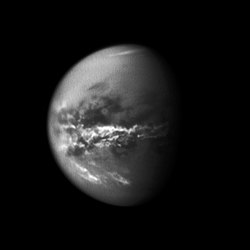Titan/Quiz
Titan is a lecture about an astronomical object in orbit around Saturn.

This is a quiz based on the lecture.
Your are free to take this quiz at any time.
To improve your score, study the lecture/article and its links, including See also, External links.
Having the lecture open in a second browser window may help you to associate the content of the question with the lecture material.
Take the quiz as often as needed to improve your score, increase your familiarity with the subject, and improve your test-taking skills.
Enjoy learning by doing!
Quiz
edit
See also
editExternal links
edit- Bing Advanced search
- Google Books
- Google scholar Advanced Scholar Search
- International Astronomical Union
- JSTOR
- Lycos search
- NASA's National Space Science Data Center
- NCBI All Databases Search
- Office of Scientific & Technical Information
- PubChem Public Chemical Database
- Questia - The Online Library of Books and Journals
- SAGE journals online
- The SAO/NASA Astrophysics Data System
- Scirus for scientific information only advanced search
- Spacecraft Query at NASA.
- SpringerLink
- Taylor & Francis Online
- Wiley Online Library Advanced Search
- Yahoo Advanced Web Search